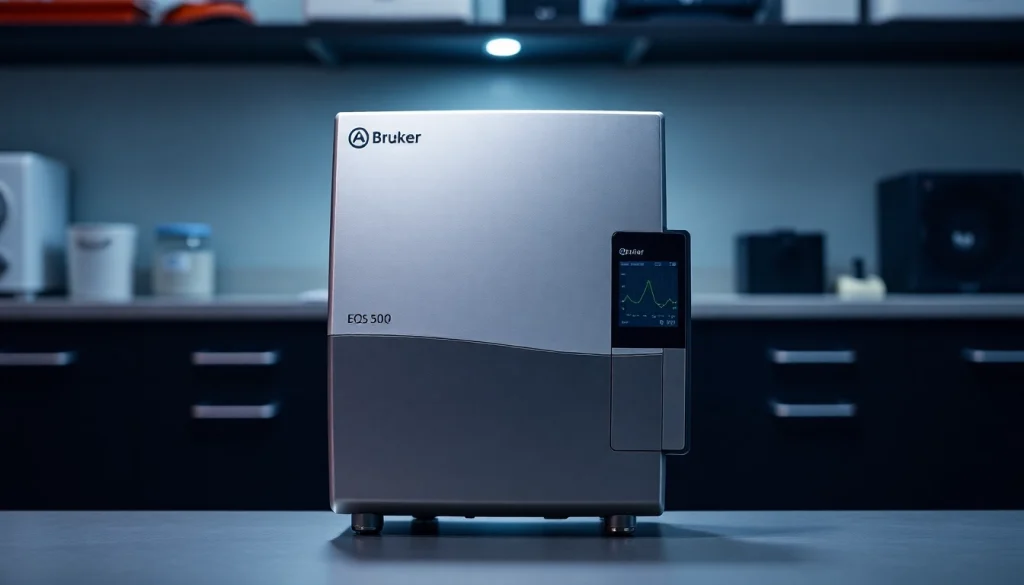Introduction to the Bruker EOS 500 Handheld LIBS Analyzer
The Bruker EOS 500 Handheld LIBS Analyzer represents a significant advancement in portable materials analysis, targetted for professionals across multiple industries. Leveraging Laser-Induced Breakdown Spectroscopy (LIBS) technology, this device enables rapid, non-destructive testing and analysis, streamlining workflows and enhancing decision-making processes. Equipped with superior detection capabilities, it provides real-time, accurate results that professionals in metal processing, environmental monitoring, and academic research have come to depend on. Central to making the most informed decisions, the Bruker EOS 500 Handheld LIBS Analyzer is a game-changer for those seeking precision in material testing.
What is a Handheld LIBS Analyzer?
Handheld LIBS analyzers are advanced analytical tools that utilize laser-induced breakdown spectroscopy to identify and quantify materials’ elemental compositions. They operate by directing a focused laser pulse onto a sample surface, causing the material to vaporize and create a plasma. This plasma emits light spectra that a sensitive detector analyzes to identify the elemental makeup of the sample. The mobility of handheld devices allows users to perform on-site analysis, which is particularly beneficial in fieldwork settings where laboratory access is limited or impractical.
Key Features of the Bruker EOS 500
The Bruker EOS 500 comes equipped with numerous features designed to enhance usability and precision:
- High Sensitivity: The analyzer can detect low concentrations of elements, making it ideal for various applications.
- Real-time Analysis: Users receive immediate results, facilitating quicker decision-making.
- Lightweight Design: Portability is crucial for fieldwork, and the EOS 500 is designed for ease of handling.
- User-friendly Interface: The device is equipped with intuitive software that simplifies operation and data interpretation.
- Robust Build: Designed to withstand the rigors of fieldwork, the EOS 500 is both durable and reliable.
Applications in Various Industries
The versatility of the Bruker EOS 500 makes it suitable for a wide array of industrial applications. Here are some key industries utilizing LIBS technology:
- Metals and Mining: The analyzer is vital in quality control and material verification processes in manufacturing and recycling.
- Environmental Monitoring: It enables the assessment of soil and water pollutants, providing crucial data for environmental studies.
- Academic Research: Researchers use this technology for various experimental purposes and to validate laboratory results.
- Forensics: Handheld LIBS analyzers assist in crime scene investigations by detecting elemental residues.
Understanding LIBS Technology
How LIBS Works: A Technical Overview
The fundamental principle behind LIBS lies in its ability to perform elemental analysis through the excitation of atoms in a material. When the laser pulse strikes the sample, energy from the pulse ionizes the atoms, producing a microplasma. The subsequent emission of light from this plasma is characteristic of the elements present in the sample. The emitted light is captured and analyzed using spectroscopic techniques, translating the spectral data into quantitative and qualitative information about the elemental composition.
Benefits of Using LIBS for Material Analysis
LIBS technology offers several advantages in material analysis:
- Non-destructive Testing: LIBS does not alter the sample, preserving it for further testing if needed.
- Minimal Sample Preparation: The process requires little to no sample preparation, expediting the analysis timeline.
- Capable of Analyzing Various Materials: LIBS is effective on solids, liquids, and powders, making it highly versatile.
- Cost-Effective: As a portable solution, it reduces the need for dedicated lab space and resources in many applications.
Comparative Analysis: LIBS vs. Other Techniques
When compared to traditional analytical techniques like X-ray fluorescence (XRF) or inductively coupled plasma mass spectrometry (ICP-MS), LIBS provides unique advantages. For instance, while XRF requires a stable, controlled environment for reliable readings, LIBS can perform effectively in varied field conditions due to its portability. Additionally, LIBS offers rapid results, which is a critical factor in time-sensitive applications, despite generally being less precise than ICP-MS for trace analysis. Understanding the context and specific application requirements will help determine the most suitable method for material analysis.
Operational Guide to the Bruker EOS 500
Setup and Calibration Process
Starting with the Bruker EOS 500 requires a straightforward setup process that ensures accurate results. The following steps outline the procedure:
- Unboxing and Inspection: Verify that all components are in good condition and included in the packaging.
- Charging the Battery: Ensure the device is fully charged before the first use to avoid interruptions.
- Calibration: Use standard reference materials to perform calibration before conducting measurements. The device should be calibrated regularly to maintain accuracy.
Best Practices for Accurate Measurements
Achieving the most accurate readings with the Bruker EOS 500 requires adherence to best practices including:
- Clean Sample Surfaces: Ensure that the sample area is free from contaminants to avoid inaccurate readings.
- Consistent Laser Settings: Use consistent energy settings and pulse durations to maintain measurement reliability.
- Sample Placement: Position the sample appropriately to maximize laser impact for the best results.
Common Challenges and Troubleshooting
Like any sophisticated analytical tool, the Bruker EOS 500 may present users with challenges. Here are some common issues and recommended troubleshooting strategies:
- Poor Signal Quality: This could be attributed to minimal laser contact with the sample; adjust position or increase laser energy.
- Inconsistent Results: Ensure proper calibration and standardization before analysis to minimize variability.
- Battery Issues: If the device fails to operate, ensure that it is fully charged and check for software updates that may affect performance.
Case Studies: Success Stories with the Bruker EOS 500
Metal Industry Applications
One case study in the metal industry involved a leading recycling company utilizing the Bruker EOS 500 to analyze scrap metal grades. The on-site analysis allowed for the rapid sorting and grading of materials, enhancing efficiency by reducing processing time by over 30%. This not only streamlined operations but also maximized the profitability of recycling endeavors.
Environmental Monitoring Scenarios
Environmental scientists deployed the Bruker EOS 500 in a project assessing soil contamination levels around an industrial site. The real-time data retrieved helped in the immediate identification of harmful elements, thereby enabling rapid response actions to mitigate potential environmental damage. Quantifying elements such as lead and cadmium quickly provided critical information to stakeholders.
Academic Research and Development Insights
Researchers at a prominent university adopted the Bruker EOS 500 in their materials science department for experimental analysis in metallurgical studies. By using LIBS technology, they were able to understand alloy compositions in real-time, leading to important breakthroughs in material design and resilience studies. The ability to perform experiments without lengthy preparations encouraged innovative approaches within the academic community.
Future of Handheld LIBS Analyzers
Emerging Trends in Material Analysis
As the field of materials analysis evolves, several trends are becoming apparent. Advancements in artificial intelligence and machine learning are set to improve data interpretation capabilities significantly. The integration of these technologies into handheld LIBS analyzers could lead to improved accuracy in results and predictive analytics that anticipates material behavior in different environments.
Innovations and Upgrades in the Bruker EOS Series
Bruker is dedicated to innovation, continuously upgrading the EOS series to include enhanced optical systems and improved software features for data processing. Such enhancements not only boost the device’s analytical capabilities but also expand the types of materials that can be analyzed effectively, further broadening its application landscape.
Preparing for Future Challenges in Material Testing
The future of material testing will undoubtedly present challenges, particularly concerning the increasing complexity of materials and the regulatory landscape surrounding environmental safety. The design and functionality of handheld LIBS analyzers will need to adapt rapidly to meet these challenges. Continuous user feedback and collaborative developments may pave the way for even more robust and flexible testing solutions in the years to come.


